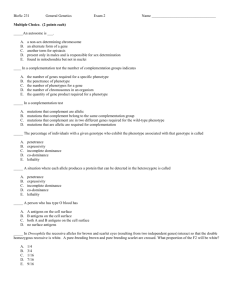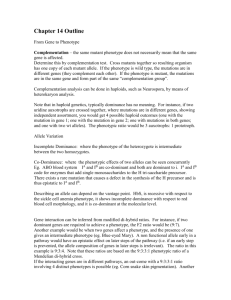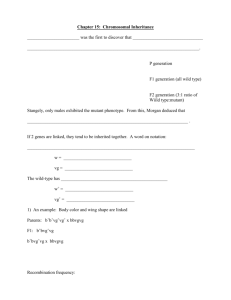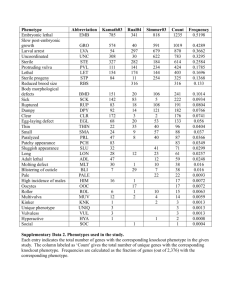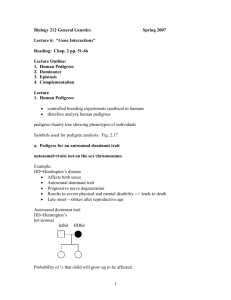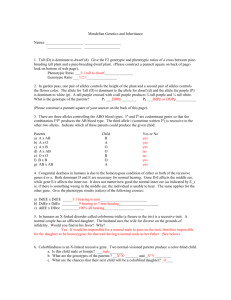BioSc 231 Exam 2 2005
advertisement
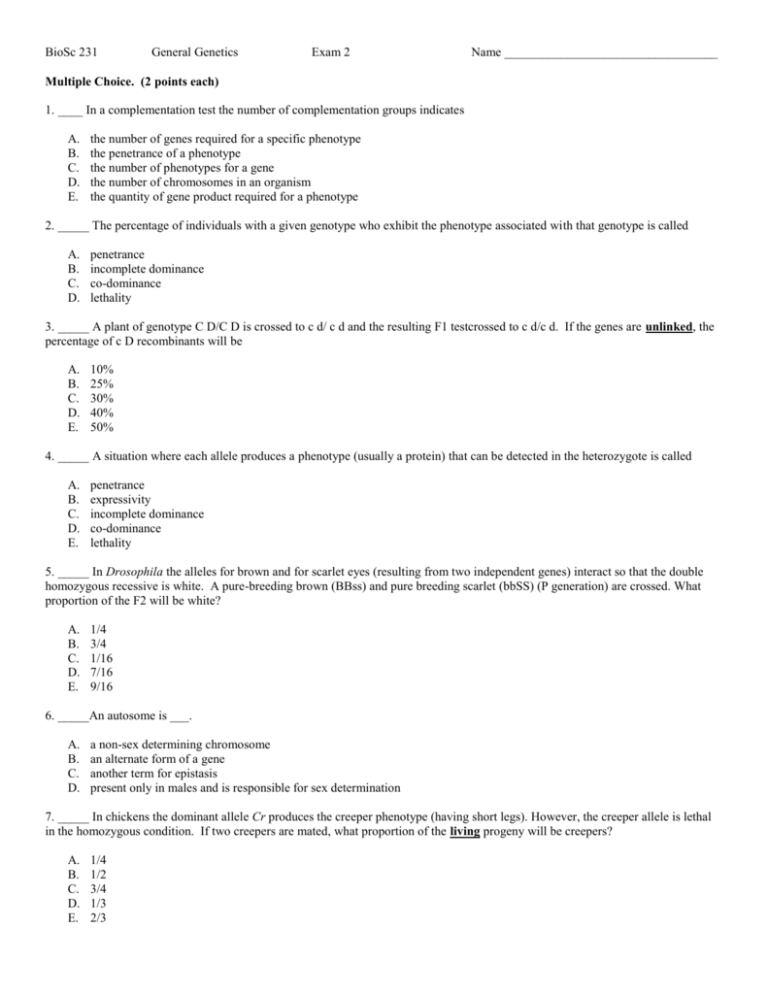
BioSc 231 General Genetics Exam 2 Name __________________________________ Multiple Choice. (2 points each) 1. ____ In a complementation test the number of complementation groups indicates A. B. C. D. E. the number of genes required for a specific phenotype the penetrance of a phenotype the number of phenotypes for a gene the number of chromosomes in an organism the quantity of gene product required for a phenotype 2. _____ The percentage of individuals with a given genotype who exhibit the phenotype associated with that genotype is called A. B. C. D. penetrance incomplete dominance co-dominance lethality 3. _____ A plant of genotype C D/C D is crossed to c d/ c d and the resulting F1 testcrossed to c d/c d. If the genes are unlinked, the percentage of c D recombinants will be A. B. C. D. E. 10% 25% 30% 40% 50% 4. _____ A situation where each allele produces a phenotype (usually a protein) that can be detected in the heterozygote is called A. B. C. D. E. penetrance expressivity incomplete dominance co-dominance lethality 5. _____ In Drosophila the alleles for brown and for scarlet eyes (resulting from two independent genes) interact so that the double homozygous recessive is white. A pure-breeding brown (BBss) and pure breeding scarlet (bbSS) (P generation) are crossed. What proportion of the F2 will be white? A. B. C. D. E. 1/4 3/4 1/16 7/16 9/16 6. _____An autosome is ___. A. B. C. D. a non-sex determining chromosome an alternate form of a gene another term for epistasis present only in males and is responsible for sex determination 7. _____ In chickens the dominant allele Cr produces the creeper phenotype (having short legs). However, the creeper allele is lethal in the homozygous condition. If two creepers are mated, what proportion of the living progeny will be creepers? A. B. C. D. E. 1/4 1/2 3/4 1/3 2/3 8. _____ The maximum recombination frequency between two genes is A. B. C. D. E. 100% 80% 50% 10% 1% 9. _____ In a complementation test A. B. C. D. mutations that complement are allelic mutations that complement belong to the same complementation group mutations that complement are in two different genes required for the wild-type phenotype mutations that are allelic are required for complementation 10. _____ The maize genes bl and ue are linked, 30 map units apart. If a plant bl+ ue/bl ue+ is testcrossed, what proportion of the progeny will be bl ue/bl ue? A. B. C. D. 0.03 0.15 0.20 0.50 11. _____ In sweet peas, the two allelic pairs C, c and P, p are known to affect pigment formation in the flowers. The dominants, C and P, are both necessary for colored flowers - absence of either results in white. A dihybrid plant with colored flowers is crossed to a white one which is heterozygous at the “c” locus. What are the genotypes of these two plants? A. B. C. D. E. CcPp and Ccpp CCPP and Ccpp ccpp and Ccpp CcPp and ccpp CcPp and ccPp 12. _____ Assume that an additional allelic pair in sweet peas also affects pigment formation in addition to the genes mentioned in the previous question. The presence of the dominant R allele is required for red flowers and the recessive r allele produces yellow flowers. Which of the following genotypes would result in red flowers? A. B. C. D. E. CcPpRr CcppRR CcPPrr ccPPRR CcppRR 13. _____ In humans, the dominant alleles, D and E, are both required for normal development of the cochlea and the auditory nerve, respectively. The recessive alleles, d and e, can result in deafness due to impairment of these essential parts of the ear. Which of the following sets of parents would produce all hearing children? A. B. C. D. DDee x ddEE DdEe x DdEe Ddee x DdEe DdEe x DDEe 14. _____ In poultry, the shape of the comb varies greatly and involves at least two pairs of alleles. The allele R can result in rose shaped comb and the allele P can result in pea-shaped comb. If both of these dominants are present together, genic interaction produces a walnut comb. When a bird is carrying both recessive alleles in the homozygous condition, single comb types result. Which of the following crosses produces offspring at the ratio of 1 Walnut: 1 Rose: 1 Pea: 1 Single? A. B. C. D. E. rrPP x RRpp RrPp x RrPp RrPp x rrpp RrPp x rrPP RrPp x RRpp 15. _____ A person who has type O blood has A. B. C. D. A antigens on the cell surface B antigens on the cell surface both A and B antigens on the cell surface no surface antigens 16. _____ In crossing over A. B. C. D. Genetic exchange occurs before chromosome replication The probability of its occurrence decreases with increasing distance between the genes exchanged Occurs more frequently between two loci very close together The reciprocal exchange between homologous chromosomes is random 17. _____ A dihybrid cross results in a phenotypic ratio of 12:3:1. This type of ratio most likely results from A. B. C. D. E. incomplete dominance co-dominance epistasis co-penetrance variable penetrance Short Answer. (variable points) (4) Two-point testcrosses revealed the following map results: br__________ui 7 map units ui___________ns 3 map units A. Draw the two possible maps for these loci. B. Other than a 3 point-test cross, what other cross would resolve the two possible maps and what are the possible outcomes of that cross? Compound Tested Mutant (5) The table to the right shows the results of a series of experiments to determine the sequence of intermediates in a biochemical pathway. 4 independent auxotrophic mutants which all require compound E (an amino acid) as a nutritional supplement were analyzed with 4 compounds that are precursors in the synthesis of compound E. Each mutant was grown on a minimal medium supplemented with each of the indicated compounds. + indicates growth that is supported by the indicated precursor. Using the diagram below, show the order of the intermediates in the pathway and indicate which step in the pathway is catalyzed by each mutant by placing the letter representing the appropriate compound in each box and the number of the appropriate mutant in each circle. A B C D E 1 + + -- + + 2 -- -- -- -- + 3 + + -- -- + 4 -- + -- -- + (6) In pumpkins, jack-o-lantern shaped fruit (o) is recessive to round shaped fruit (o+). Branching vines (s) is recessive to simple vines (s+). In the P generation, plants from two different pure-breeding lines are crossed. One variety bears round fruit and has simple vines. The other variety has jack-o-lantern fruits and branched vines. The resulting F1 plants were testcrossed and the following 240 progeny were obtained: 70 46 56 68 - round, simple - jack-o-lantern, simple - round, branched - jack-o-lantern, branched Calculate the chi-square and P values based on the prediction that the genes are not linked. (chart is on the last page) (6) In corn, the genes u, m and r are linked. The data given below summarize the result of 1000 offspring from a three-point testcross. From the data, construct a map showing the genes in the correct order and indicating the distances between each pair of genes. u+ u u u+ u+ u u u+ m+ m m+ m m m+ m m+ r+ r r r+ r r+ r+ r 304 295 70 64 119 108 18 22 (5) Based on the complementation data below, A) how many complementation groups exist, and B) which mutations belong to each group? (+ = complementation, -- = no complementation) Mutation Mutation 1 2 3 4 5 6 7 8 9 1 -- 2 + -- 3 -- + -- 4 + + + -- 5 + + + -- -- 6 + -- + + + -- 7 -- + -- + + + -- 8 + + + + + + + -- 9 + + + + + + + -- -- 10 + -- + + + -- + + + 10 -- Bonus Question (4 pts) An Arabidopsis thaliana flowering mutation has been generated in the Columbia (Col) line. The mutant line was then crossed with a wild-type Landsberg erectus (Ler) line to generate the F1 generation. The F1 generation was allowed to self to produce the F2 generation. F2 plants that displayed the mutant phenotype were assayed using the CAPS system to identify a molecular marker that is linked to the mutant flowering gene. Two markers from each of the five Arabidopsis thaliana chromosomes were tested. The results of those tests were as follows. Marker Name Chromosome # with Ler Markers # with Col Markers m 235 m 305 1 top 1 bottom 43 27 51 27 PhylB/hy3 m 429 2 top 2 bottom 38 39 36 29 g 4711 BGL1 3 top 3 bottom 29 20 21 30 GA1 AG 4 top 4 bottom 44 11 38 59 r 89998 DFR 5 top 5 bottom 41 50 45 34 Which marker is linked to the flowering mutation?
